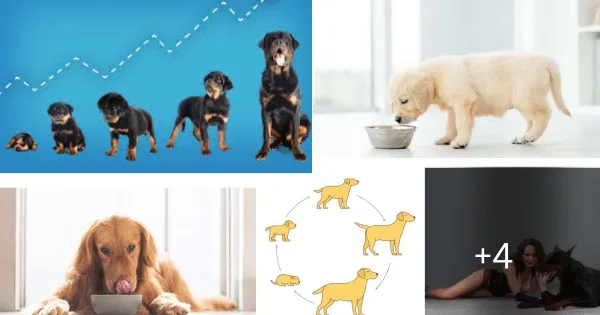Dogs growing, our loyal companions, come in all shapes and sizes, from tiny Chihuahuas to towering Great Danes. One of the most common questions among dog owners and enthusiasts is, “When do dogs stop growing?” Understanding the growth timeline of dogs can help owners provide the best care and ensure their pets develop healthily. This article delves into the factors influencing canine growth, typical growth timelines for various breeds, and how to support your dog through their developmental stages.

Factors Influencing Canine Growth
Several factors influence when and how dogs grow, including genetics, breed, nutrition, and overall health.
- Genetics: Genetics play a crucial role in determining a dog’s growth rate and final size. Each breed has its genetic blueprint that dictates growth patterns, including the age at which growth plates close and when they reach full maturity.
- Breed: Different breeds have different growth rates. Generally, smaller breeds grow faster and reach their full size earlier than larger breeds. For example, a Chihuahua may stop growing as early as six to eight months, while a Great Dane may continue to grow until they are two years old or more.
- Nutrition: Proper nutrition is vital for healthy growth. Puppies need a balanced diet rich in proteins, fats, vitamins, and minerals to support their rapid growth. Overfeeding or underfeeding can lead to health issues that affect growth and development.
- Overall Health: Health problems can impede a dog’s growth. Conditions such as parasites, infections, and hormonal imbalances can stunt growth or cause developmental delays. Regular veterinary check-ups are essential to ensure your puppy is growing appropriately.
Growth Timelines for Different Breeds
The growth timeline of a dog varies significantly between breeds. Here’s a closer look at the growth patterns for small, medium, and large breeds.
Small Breeds
Small breeds, such as Chihuahuas, Pomeranians, and Dachshunds, tend to grow rapidly and reach their full size quicker than larger breeds. Typically, small breeds stop growing between six to eight months of age. By this time, they have usually reached their adult height and weight, although they may continue to fill out and gain muscle mass for a few more months.
Medium Breeds
Medium-sized breeds like Beagles, Cocker Spaniels, and Border Collies have a slightly longer growth period compared to small breeds. They generally stop growing between 12 to 15 months. During this time, they gradually reach their adult size, but similar to small breeds, they may continue to develop muscle tone and body condition for several months afterward.
Large Breeds
Large breeds, including Labrador Retrievers, German Shepherds, and Golden Retrievers, have a more extended growth period. These dogs typically stop growing between 18 to 24 months. Large breeds grow at a slower pace, allowing their bones and joints to develop properly. It’s crucial for large breed puppies to have a diet formulated to support their slower growth rate to prevent joint and bone problems.
Giant Breeds
Giant breeds like Great Danes, Mastiffs, and Saint Bernards have the longest growth period. These massive dogs can continue to grow until they are 24 to 36 months old. Giant breeds grow slowly, and their growth plates remain open for a longer time to accommodate their large size. Owners of giant breed puppies should be particularly careful about their diet and exercise to avoid putting too much strain on their developing bones and joints.

Supporting Your Dog Through Growth Stages
Supporting your dog’s growth involves providing the right nutrition, exercise, and veterinary care throughout their developmental stages. Here are some essential tips to ensure your dog grows healthily.
- Proper Nutrition: Puppies have specific dietary needs that differ from adult dogs. Choose a high-quality puppy food that meets the nutritional requirements for their breed and size. Large and giant breed puppies often need specially formulated diets to prevent overly rapid growth, which can lead to orthopedic issues.
- Regular Exercise: Exercise is crucial for a puppy’s physical and mental development. However, it’s essential to tailor the exercise to your dog’s breed and age. While small breeds may need less intensive exercise, large and giant breeds require controlled exercise to avoid stressing their developing bones and joints.
- Veterinary Care: Regular veterinary check-ups are vital to monitor your puppy’s growth and overall health. Your vet can identify potential health issues early and provide guidance on proper nutrition, vaccination schedules, and parasite control.
- Socialization and Training: Socialization and training are important aspects of a puppy’s development. Exposing your puppy to different environments, people, and other animals helps them develop into well-rounded and confident adults. Basic training also provides mental stimulation and strengthens the bond between you and your dog.
- Monitoring Growth: Keep track of your puppy’s growth by regularly measuring their height and weight. This can help you identify any deviations from the typical growth pattern for their breed. If you notice any concerns, consult your veterinarian for advice.

Conclusion
Understanding when dogs stop growing and the factors that influence their growth is crucial for providing the best care for your furry friend. While the growth period varies significantly between small, medium, large, and giant breeds, the principles of proper nutrition, exercise, and veterinary care apply to all. By supporting your dog through their developmental stages, you can help ensure they grow into healthy and happy adults, ready to share many years of joy and companionship with you.





